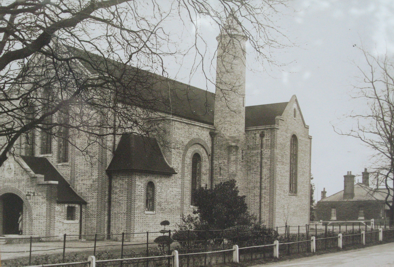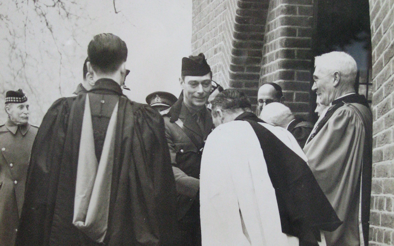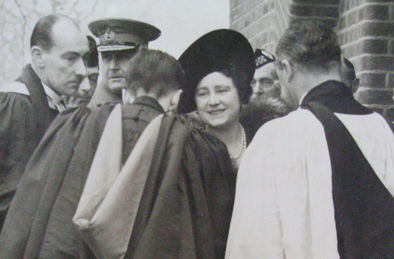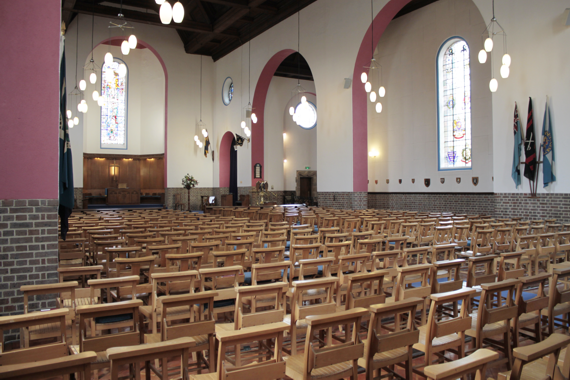The new St. Andrew’s Church of Scotland Garrison Church was opened by Her Royal Highness
, Princess Mary, who was Colonel in Chief of The Royal Scots, The First of Foot, on the morning of Saturday 10th December 1927. The bronze plaque which was unveiled by Her Royal Highness can be seen in the porch of the church.
(Directly above this bronze plaque is a sculpture of a pelican designed, in 1927, for the new church buildings, by the artist Pilkington Jackson.) The church was dedicated by the Right Rev. Norman Maclean, D.D., Moderator of the General Assembly of the Church of Scotland.
In the pulpit of the church
was a metrical psalter for the use of the chaplain and on the flyleaf is the inscription:
"
Presented to St. Andrew’s Garrison Church by One James Maclaren who was Christened in the old "Iron Kirk, 1859, by the Rev. Francis
Cannon, First Pastor."
 The church on 1st December 1927 - with full bell tower and shorter nave than the present church
The church on 1st December 1927 - with full bell tower and shorter nave than the present church
Unfortunately the original plan could not be carried out in its
entirety because of the economic difficulties of the time. The plan
consisted of a wide nave and two shallow transepts; the south transept to
accommodate the musicians and the north transept to accommodate the women
and children. The nave had to be built shorter than the architect, Sir
Robert Lorimer (who also designed the National War Memorial of Scotland)
had intended. But the church was still able to seat at least 500 people.
Economics again made it impossible to furnish the church in anything but
the sparsest way. So short was the supply of money that the inside walls
had to be left unplastered.
As the years passed it became more and more obvious that the church
was too small for the number of troops and civilians who, theoretically,
could turn up for worship on a Sunday morning. The chronic lack of space
must have been a constant headache for the Chaplains. There were at times
as many as four Scottish Battalions in Aldershot
Camp.
It is said that the event that finally led to the enlarging of the
church was the turning away from the church door of the Cameron
Highlanders. Lt. Col. R. L. MacColl, who commanded the Second Battalion
The Queen’s Own Cameron Highlanders, was due to retire in 1933. On the day
of his farewell parade someone blundered and the Camerons arrived last at
church and found it already full with men of other regiments. Sadly Lt.
Col. MacColl turned his Battalion about and marched them in silence back
to their lines. The resolve was made that something must be done about the
situation.
Money began to he raised again, but very slowly because the
economic situation was still not bright. In 1938 the trustees of St.
Andrew’s Scottish Soldiers’ Club decided to make a grant towards the
completing of the original design. This generous gesture prompted the
appropriate Committee of the Church of Scotland and The Treasury and they
added their contributions. These grants enabled the building to be
completed as the architect had first envisaged it. Sir Robert Lorimer had
died by this time so the task he had begun in 1926 was completed by his
Partner Mr. John F. Matthew, F.R.I.B.A., F.R.I.A.S. The contractors were
Messrs. Musselwhite & Son, of Basingstoke, the builders of the
original Memorial Church.
The extensions to the church were as follows : - the nave was
lengthened by 30 feet, the inside walls were plastered and an entirely new
lighting system was installed. The bell tower, which was a distinctive
feature of the church was reduced to roof level; it was felt that it was
no longer in proportion with the enlarged building. The bell was the one
which had hung in the old "Iron Church" and had called generations of
soldiers to worship. For some unknown reason it had never been rung during
its sojourn in the bell tower from 1927 to 1939. When it was taken down it
was intended to have it cleaned and polished and to set it on a stand in a
place of honour in the church. This was not to be. The bell mysteriously
disappeared and despite a concerted search, by the Chaplain and the
beadle, of scrap yards as far afield as Portsmouth it was never recovered.
Since the bell weighed over two hundredweight it is unlikely that it was
removed unknowingly. The stand which was specially made for the bell sits
brooding and neglected in one of the storerooms of the church. At this
time too the church was completely refurnished as it is today.
During the period of the extensions the congregation worshipped in
a soldiers’ canteen beside Maiplaquet Barracks and latterly in the more
congenial atmosphere of The Prince Consort’s Library.
 King George VI at the reopening and rededication service in 1939
King George VI at the reopening and rededication service in 1939
On Sunday the 5th Feb.1939, St. Andrew’s was reopened and
rededicated in the presence of King George The Sixth and Queen Elizabeth.
His Majesty wore the uniform of The Queen’s Own Cameron Highlanders, of
which he was Colonel in Chief. The Officiating Clergy included, the Rev.
J. Lynn, C.B.E., D.D., K.H.C., Deputy Chaplain-General, the Rev. A.
Fleming, T.D., D.D., the Rev. W. J. Sym, M.B.E., RD.. minister in charge
of the church from late 1939 until 1942, and the Rev. A. M. Davidson,
M.C., M.A., S.C.F., Chaplain of St. Andrew’s at the time of the
reopening.
 Queen Elizabeth at the reopening and rededication service in 1939
Queen Elizabeth at the reopening and rededication service in 1939
The photograph of the church in 1927 and those of King George and Queen Elizabeth may be subject to revived copyright. The church has been unable to identify the photographer(s). If you have any information on the photographer(s) we should be grateful if you would write to or email the church using the address at the top of the page.






